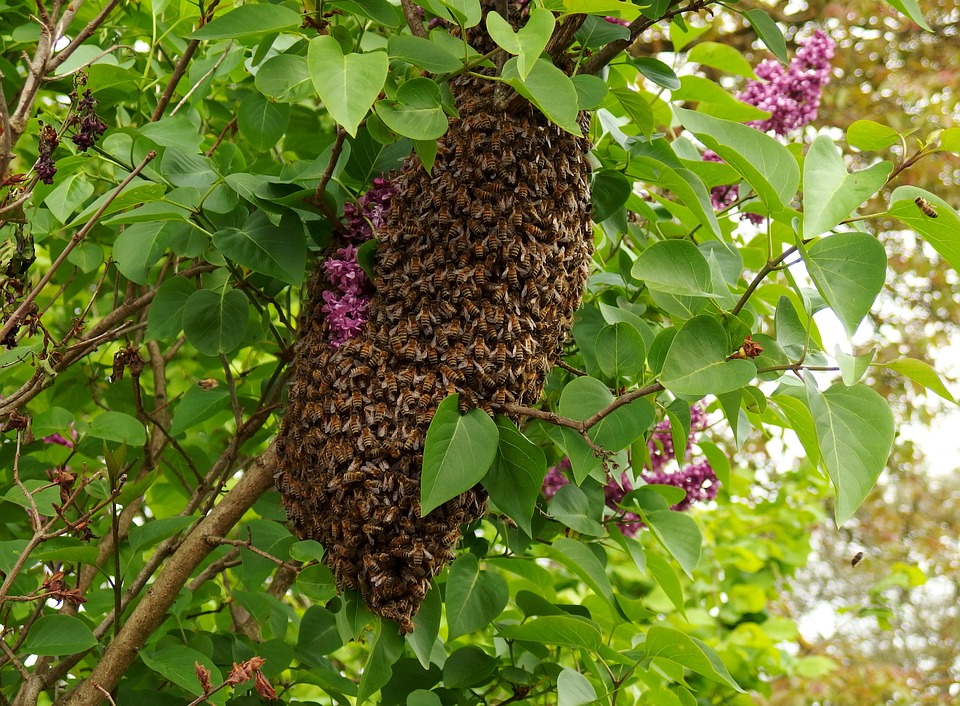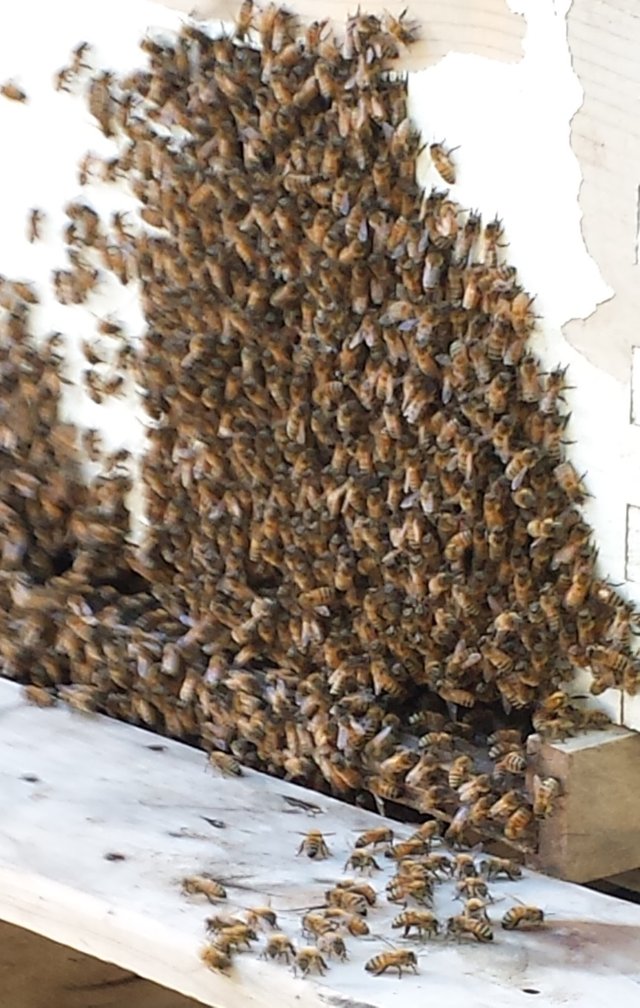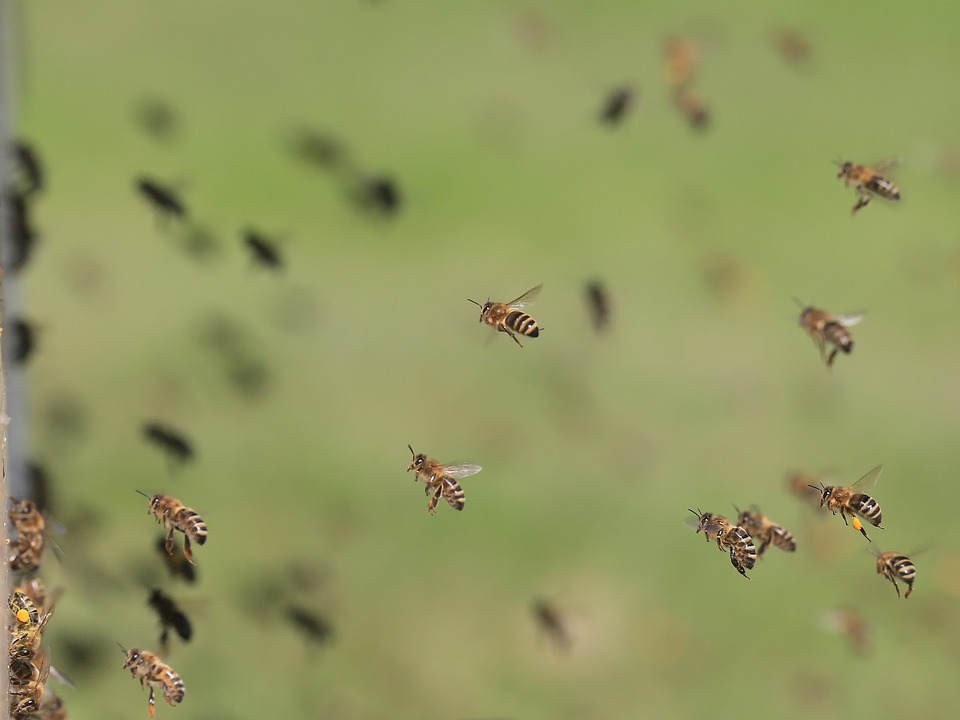Learning the Art of Beekeeping -- Part Seven

The following is a small excerpt from my previously published book, The Beekeeper's Guide.
Swarm Catching
If you are interested, there are free bees all around you. You may or may not have noticed them in your area, but I am sure they are there. There are several ways to get wild hives or swarms. The easiest way is to get on the local call list. Almost every area has a call list kept by the local or state beekeeper association. Whenever they get a call from a concerned homeowner about a swarm that has landed on their house or somewhere in their yard, they call the next interested beekeeper on the list. If your name is next, they will give you a call. Most associations don’t worry too much if you can’t make it when they call, they will just give the next person in line a call and put you back at the end of the list.
What do you do if you get the call? Well, put on your beekeeping equipment and head over to the address you are given. Even if you don’t know much, the homeowner probably knows even less. So just act natural and get to work.
When you arrive, determine where the swarm is located. Often, they will have landed on a tree branch or bush. If this is the case, you are in a bit of luck. Other times, they land on the side of a house or outbuilding. Not as easy, but still in the realm of do able.
The swarm will most likely number between 20,000 and 40,000 or more bees. When bees swarm, a good portion of the colony’s bees leave the hive with the old queen. She leaves before a new queen comes out of her cell and dethrones her. This is nature’s way of growing the species.
When they leave the original hive, it is like a cyclone of bees. A great buzzing sound will start to rise to a crescendo and then thousands of bees will spill out of the hive. The swirl up and up and then fly away. The old queen is in the middle of this bee tornado. After a few hundred yards or maybe a bit more, the swarm lands. They will spend the next few hours to the next three days in this location. This is when you get the call from a panicked homeowner.

The swarm may not seem to be, but is very docile. While camping out for a few days, the swarm sends out scout bees to find the ideal new home for the swarm. As each scout returns, the hive makes a decision. Once an ideal spot is found, they all fly off and start their new home. Since there is already an old queen in place, she will begin to lay as soon as there is honeycomb available.
While they are camping out, the hive will buzz merrily and probably scare the local homeowners. But never fear, you know something they don’t. The swarm isn’t territorial because it has no home. And all of the bees are full up with honey, so they will have a difficult time stinging anyway. You see, before they left the old hive, they all filled up with honey so they would have enough starter food to get the new hive started.
So here is what you do. Approach the swarm gently. If you want to smoke them, that isn’t a bad idea. But don’t smoke them too much; you really don’t want to spook the swarm. And then, if they are on a thin branch, stick a good sized cardboard box below them. Cut off the branch they are on (if that is ok with the homeowner—they are normally so worried that they would probably give you permission to raid their fridge if it would help get the bees off their property—but don’t take advantage). Gently lower the branch into the box. Close the lid. Take your new swarm home and stick it in a hive box. Voila! You have a free colony of bees for a minimal amount of work.
But, if things aren’t that easy, here are some more tips and tricks to help you with a swarm recovery. I have seen swarms on the ground, on a sandbox, on a tree fork and on a chain link fence to name a few locations. The toughest one was the chain link fence.

And that leads us to our funny story of the day. I left for church one Sunday a bit earlier than my family. I had a short meeting to attend before the regular church meeting. We had brand new, next door neighbors that had moved in maybe a month or less before. Between our two backyards, we have a full size vinyl fence. In the front yard, there is a chain link fence between the two yards. A huge vine grows all around and through the chain link fence; otherwise we probably would have traded it out for vinyl years ago. Anyway, my family shows up for church and tells me one of the hives has swarmed. I’m nervous out of my mind, because I have never dealt with a swarm before. And the worst news possible, in my mind at the time, was that the swarm didn’t bother just leaving Dodge and heading over into the wild lands a few blocks away from our house. Instead, the old queen made it all of about 30 feet and landed with her 40,000 attendants on the chain link fence between my house and my new neighbor’s house.
So when I get home from church, I look at the swarm and think, how hard can it be. I get my equipment on—this is back when I had a simple hanging bee veil instead of the full jacket. I get out to the hive, my hands are sweating and I am nervous. Nervous I’m going to really make my new neighbors mad and nervous I am about to get stung silly by this swarm.
As I get close, I realize there is no easy way to do this. The bees are all over in the individual chain links. No easy “cut-the-tree-branch-and-done” situation for me. I begin to reach in slowly and pull gobs of bees off of the fence and drop them in the box. I don’t realize at the time, that if you don’t have the queen in the box, the bees will just fly out of the box and get back to her. After several minutes of acting out a modern day version of Sisyphus, I realize I am making no progress and am only enraging the poor bees. There are several thousand bees now flying about in a panic. I have stirred them up into righteous indignation. And I still don’t realize I need to get the queen. By now, several of the bees have stung my exposed parts. They are climbing inside my veil. I want to scream with terror. But I can’t. I look into my house and there are my six beautiful children and my wonderful wife staring at me—expecting me to have success. How can I fail with them watching?
Well, after about five more minutes, which seemed like an eternity burning and stinging in the coals of Hell, I finally ran away and chickened out, seeking relief from the incessant attacks in my backyard. I licked my wounds. I read more about how to capture a swarm. And then I gave up. I meekly waited two more days for the hive to just up and leave. I was so grateful when they left. I felt like I could finally untuck my tail from between my legs and start holding my head up high again.
And from my failure, I learned a few lessons. Get a good bee jacket. You will be grateful you did. And when you work with a swarm, spend the time necessary to identify where the queen is. And then get her into your carrying box first thing. If you do, everything else will be smooth sailing. If you fail to get her, like I failed in my first bee swarm retrieval effort, then you will eventually end up angering 40,000 bees and you may pay a bit of a price for your failure.
I don’t share this story with you to make you nervous. I have collected many swarms since then. The last three swarms I collected I managed not to collect a single sting. I just tell you so you don’t make the same mistakes I did.
Wherever the swarm is, get your cardboard box close. Then, try and manipulate the center of the swarm into your box. You can gently scrape them with a piece of cardboard into the box. Or you can pick them up with your hands. What you are trying to do is get the queen into the cardboard box. The swarm will take all their clues from her. If you get her in the box, you can actually just wait patiently from there and the rest of the bees will slowly migrate into the box so they are close to her.
I don’t much like waiting for the slow migration, so what I generally do is once I have the queen in the box, I begin to scoop handfuls of bees into the box atop the queen. Several hundred of the bees will begin to buzz loudly and will fly around bumping into you. They are warning you that they aren’t happy with you. But you have your suit on—so don’t sweat it too much. Just keep working slowly and after five or ten minutes, you will most likely have about 70% of the bees in the box. From there, just walk ten or twenty feet away from the box and wait a while. The rest of the bees will slowly settle down and land either where they were or in the box with the queen.
Now you have a decision. You can leave the bees that are not yet in the box in place and depart with your queen and her several thousand attendants that you already have boxed up, or you can try and get the rest. I feel it rather unkind to leave any bees behind. Left behind, they are sure to perish. So I generally spend as much time as I need to collect as many bees as humanly possible. Realize that you probably are never going to get them all. But, gather as many as you can. Thank the homeowner for the call. Tell them the few remaining bees will leave in the next three days and instruct them to just leave them alone until they depart. And then go home and put your bees in their new hive.
Can you depend on getting a swarm hive in a timely manner? Not really, it seems to happen when you least expect it. But in my world, a free swarm colony is welcome in my yard anytime I can get one. So for your first hive, I would purchase a packet of bees. But from there, if you get a call, why not go help your neighbor and get a free colony in the act of service. You will never believe how grateful the homeowners are when you leave with all those bees. A really thoughtful beekeeper would even take the homeowners a jar of honey as thanks for their call. Your gratitude will work wonders with them and you can certainly expect future calls from them or their friends if they ever get another swarm in their yard.
A note of caution. If the swarm in question is actually within the walls or roof of a house, I always defer to a professional removal service. There are just too many liability issues with trying to get bees out of a house. And the same goes if the hive is in a dangerous location such as too high in a tree. There is no shame in telling the homeowner you aren’t set up to get that particular hive. Just help them call someone who can take care of it for them and head on your way.

My book, The Beekeeper's Guide, is available for purchase on Amazon right here.
© 2015, Stone Golem Publishing, All rights reserved--no part of this may be used without express written consent.
**The pictures are all from Wikipedia or Pixabay and labeled for reuse with no stipulations.
Follow @bigpanda for more flash fiction and homesteading tips.
Dude! If a swarm of bees come at me, it's enough to scare me enough to run away. I'm not even thinking about them looking for a new home or being filled with honey.
Intense times you must have had there, it looks great on paper until you try it haha.
It got me thinking, they are looking for a new home, so could you not just put a nice cosy home next to them, and if they take to it, move it to a new preferred location.
These Ive seen used with success in my apple orchard
cool the world of bees is like a whole new world.
thyanks for sharing with us all do you know about the bees. Have a wonderful week. Blessing
You have a wonderful week as well @denissemata.
Great post, but the swarm in the tree, scare me. Lol
I'll admit, the first time I encountered a swarm, I was a bit nervous as well.
Abit nervous? Id run like the wind. Lol
Great post! I posted something similar, had I seen this first I may have hesitated to post mine! This is great stuff right here! Upvote!
Thinking about catching some :P
a great post my friend, indeed we delicate learn sebulum we do something.
good luck always my friend @bigpanda.
i will upvote and resteem.
you love the apiary, breed the bee. I enjoyed reading your post, the honey that they collect is very healthy for health, thank you that you show us your wealth of nature in steemit
wow, amazing, very good post friends, my resteem yes, if any time, visit my blog buddy yes.
A good and interesting story from bees, I love it. success is always for you @ bigpanda friends.
Bees are scary, but the results of honey made very useful.